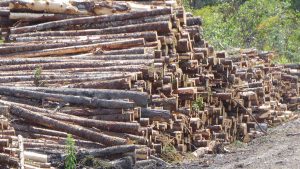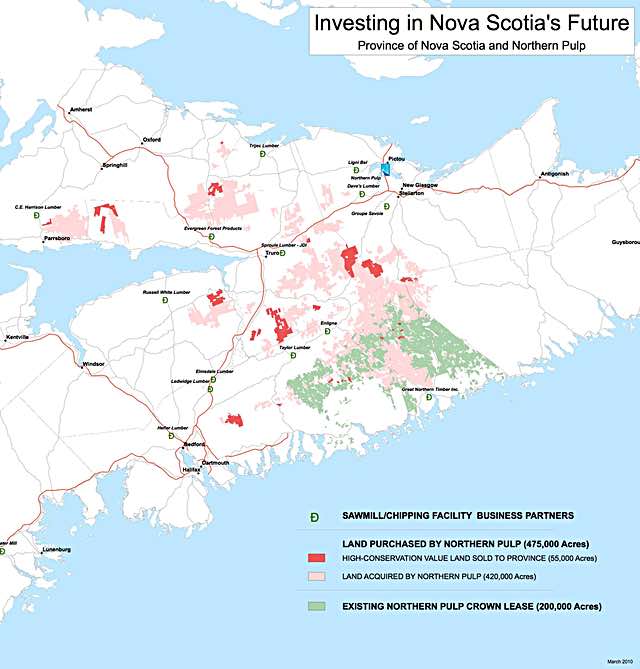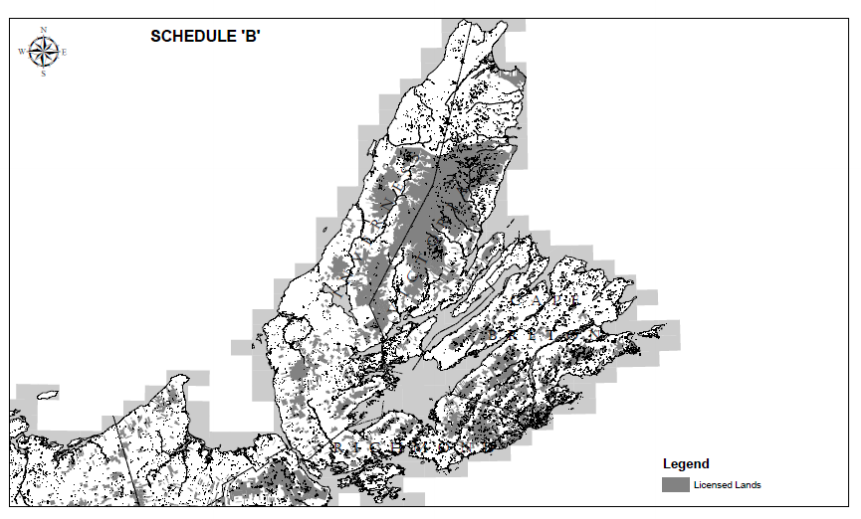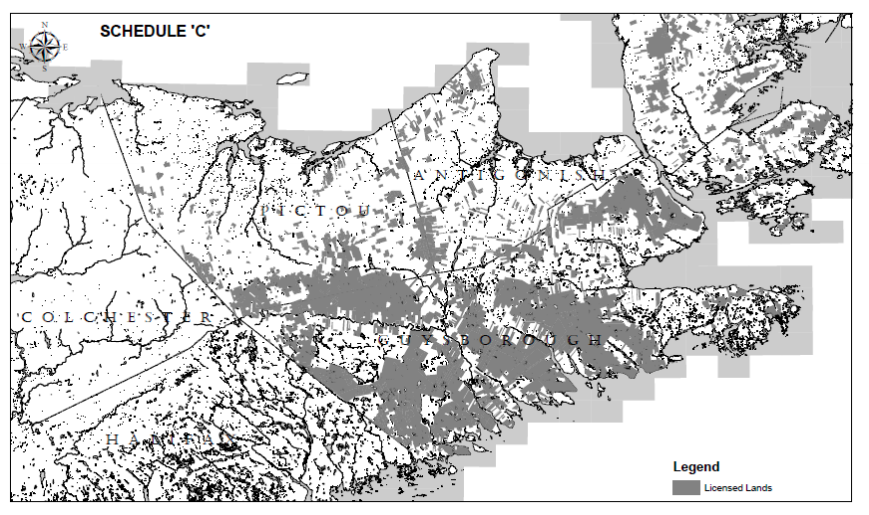Some sources of statistics for Nova Scotia Forests
Nova Scotia Government’s Open Data Portal
“Making government data easier to access for individuals, businesses, and researchers”
Nature & Environment
Featured Dataset: Forestry Education & Skills Resources
Featured Dataset: Low Carbon Communities Fund
Canada’s Timber Supply: Current Status and Future Prospects under a Changing Climate
Dan McKenney et al., 2016. 75 pages. Many stats by province and for Canada at large.”We first review historical harvests and allowable cut levels, place Canada’s forests in an international context, and briefly review global timber market studies that examine the implications of a changing climate…The second part of this report uses bioeconomic modelling to examine the national timber supply question from the growing and delivery-to-mills perspective. This analysis, which represents the first effort of its kind at this scale in the country, attempts to model changes in delivered wood supply costs, taking into account the current forest inventory (at a ~500 metre grid resolution) and projected changes in growth and yield and fire disturbance regimes under climate change.
For NS here are some key assumptions
| Total quantity of hardwood required (m3 ) |
Softwood | Number of mills | Area of forest allocated (ha) |
| 624,234 | 2,734,147 | 37 | 5,082,200 |
(They seem to assume all forest in NS is available for harvest)
Economic Impacts of Northern Pulp Nova Scotia
Gardner Pinfold Consultants for Unifor, August 2019. 38 page document. The sky is falling, details about NS sawmills, supply chains etc. in doc
NSDNR ANNUAL REPORTS
– Business Plan (2019-2020)
– Statement of Mandate (2015-2016)
– Accountability Report (2015-2016)
– Registry of Buyers of Primary Forest Products 2018 Calendar Year / June 2019
NSDNR stats for 2017 “The total reported provincial harvest for 2018 was 3,359,872 cubic metres of solid wood. Of this amount, 81% or 2,708,426 cubic metres were softwood species. The total volume of wood acquired for export was reported to be 242,193 cubic metres, or 7% of the total harvest. The total volume of wood imported for use in Nova Scotia was reported to be 210,677 cubic metres, or 6% of the total wood consumed in Nova Scotia. The provincial harvest for 2018 shows an increase of 2% compared to the 2017 harvest of 3,292,525 cubic metres…..A Note (p8): The volume of firewood harvest included in this report reflects only the amount acquired by registered commercial firewood businesses. Firewood businesses acquiring less then 1000 m3 are not required to register. However, through review of the Statistics Canada 2011 Census; The Statistics Canada Households and the Environment Survey, 2013; and the N.S. Dept. of Energy, Thinkwell Customer Behavior Study, 2008; the Department of Natural Resources estimates that as much as 444,000 cubic metres is used as a household energy source on an annual basis in Nova Scotia.
Past reports (2000-2017) are available.
Registry of Buyers
“The Registry of Buyers is a registry of individuals and businesses who acquire primary forest products for processing into secondary products, export, sale as firewood, or production of energy. The Registry of Buyers provides reliable data to help the public, business, and government understand wood demands and estimate sustainable harvest levels. This will help determine long-term resource management needs and identify value-added opportunities for our forest products.”
Also see
– Sustainable Forestry Fund (NSDNR) “The Forest Sustainability Regulations require Registered Buyers provide for silviculture on Nova Scotia forest land in proportion to the value of primary forest products they acquire in a year.”
– Association for Sustainable Forestry (ASF)
“The Association works with silviculture contractors, woodland owner groups, and individuals to allocate and monitor the silviculture funds available through the provisions of the Nova Scotia Forests Act. Serving as a conduit between woodland owners and the forest industry, the Association is dedicated to ensuring the future health and enhancement of resources on privately owned woodlands.” View Silviculture treatments funded through ASF
– NSDNR Report on Prices for Standing Timber Sales from Nova Scotia Private Woodlots for the Period April 1, 2015 through March 31, 2016 “It is the policy of the Nova Scotia Department of Natural Resources (“NSDNR”) to set its Crown land stumpage rates (i.e., the price paid for the right to harvest standing trees on Crown lands) consistent with fair market value. In order to estimate the fair market value of stumpage in the Province, NSDNR commissions periodic surveys of Registered Buyers who routinely purchase stumpage from independent private land owners in a competitive marketplace…A project to collect and report on private woodlot stumpage prices in the Province was initiated in the summer of 2016…Deloitte collected transaction data covering Softwood sawlogs & Softwood studwood and lathwood…”
State of the Forest Report 1995-2005: Nova Scotia Forests in Transition
NSDNR
State of the Forest Report 2016
NSDNR
Forest area harvested 1975-2011
StatsCanada
Area harvested for Nova Scotia 1975-2011:
lowest area harvested: 26,285 ha in 1976
Largest area harvested: 69,761 ha in 1997
Peak period: 1994-2005, range 49,084-69,761
(for all other years, harvests were less than 45000 ha)
Area harvested 2011: 40,954 (43963*)
Area harvested 2015: 34777*
Area Harvested by Ownership and Harvesting Methods, 1990-2015
National Forestry Database
Area harvested for 2015:
total area harvested: 34777 ha
total clearcut (EAM, even-aged management ): 30937 ha (89.0% of total)
total Crown land harvested, long term license: 8756 ha (83.8% EAM)
total Crown land harvested, other tenures: 2586 ha (83.1% EAM)
all Crown land harvested: 11342 ha (83.7% EAM)
industrial lands harvested: 3881 ha (91.3% EAM)
non-industrial lands harvested: 19554 (91.6% EAM)
total private lands (industrial & other): 23435 ha (91.5% EAM)
Provincial Timber Objective (PTO)
A Set of NSDNR presentation slides distributed as PDF to participants in some DNR hosted events to explain how NSDNR estimates the sustainable timber supply. The PTO document (set of slides) is not available on the NSDNR website, but presumably could be obtained by request from NSDNR. I received a set dated Feb 17, 2016 as a participant in a workshop set up by the Independent Review of Forest Practices in Feb., 2018. It includes stats on the “working land base” which are not readily available elsewhere:
Total Land Area (NS): 5,7270,110 ha
Protected Area Land: 472430 (358757 forested)
Land Outside Protection: 4,797,680 ha
Forested Landbase: 3,766,003 ha
Forested Landbase Exclusions: 763,2713 ha (e.g. Old Growth Policy, lichen buffers etc)
Working Forest Landbase: 3,002,730
Working Landbase Restrictions: 954,726 ha (e.g. watercourse buffers, deer wintering areas)
Working Landbase No Restrictions: 2,048,004 ha
Working Landbase No Restrictions that is Crown Land: 27% or 552961 ha
Working Landbase No Restrictions that is Industrial Freehold: 10% or 149054 ha
Working Landbase No Restrictions that is Private: 55% or 1,126,402
Calculated harvest intervals for Crown and Private Lands
Combining the PTO stats for the working landbase with stats for areas harvested in 2015 (National Forestry Database, above), the percentages of working land harvested in 2015 and the inferred harvest intervals were estimated as follows:
A: Crownland working landbase no restrictions is 552961 ha; 11342 ha or 2.05% of the area was harvested in 2015 which corresponds to a harvest every 48.8 years
B: Industrial working landbase no restrictions is 149,054 ha; 3881 ha or 2.60% of the area was harvested in 2015 which corresponds to a harvest every 38.5 years
C: Private Working Landbase No Restrictions is 1,126,402 ha; 19554 ha or 1.73% of the area was harvested in 2015 which corresponds to a harvest every 57.8 yearsThere may be some errors in combining the numbers from these two datasets because of sales of industrial land to government, some of which is then leased back to industry, so I calculated
D: Private and Industrial Land no restrictions is 73% of 2,048,004 ha = 1,495,043 ha; 23435 ha or 1.57% was harvested in 2015 which corresponds to a harvest every 63.7 years
Distribution of employed people, by industry, by province
StatsCanada
Employment For Nova Scotia, 2017:
All Industries: 449,000
Goods-Producing Sector: 81,300
Forestry, fishing, mining, quarrying gas & oil: 10,100
Services-producing sector 367,700
Forest industry employment (Nova Scotia)
StatsCanada
Labour Force Survey (no of jobs) for 2016:
Forestry and logging industry – 883
Pulp and paper product manufacturing industry – 1000
Support activities for forestry industry – 1383
Wood product manufacturing industry – 2,017
Total – 5467
Panta Rei blog: economics of forestry in Nova Scotia & changes in forests and employment
Three posts made in March/April 2017 address the forest economy in N.S.: NS Budget, Economics and Employment With comparison to Tourism, Analysis of the economics of forestry in Nova Scotia, From ships to chips, Nova Scotia Forestry analysis.
Forest sustainability in the province of Nova Scotia, Canada
GDF Suez- Electrabel Report Oct 2014. Good overview at the time of the report
Laws, logs and lumber : a history of forest legislation in Nova Scotia
Gillian Allen 1993 MA Thesis at SMU 1993 “This thesis examines the development of comprehensive forest management from the late eighteenth century to the Lands and Forests Act, S.N.S. 1926, c. 4, particularly concentrating on Crown lands management (or lack thereof). In addition, the study focusses on “the business” of the forest and legislative attempts to impose order on competing forest uses as well as governmental responses to forest fires and forest pests. An analysis of various legislative measures is set against the context of politics and legal development in late eighteenth and nineteenth century society, politics and legal development. The Journals and Proceedings of the House of Assembly of Nova Scotia and the Statutes of Nova Scotia provide the most tangible evidence of that most ephemeral of legal fictions “the intent of the legislators”. But by piecing together the Reports of the Commissioners of Crown Lands, the Game Commissioners Reports, the wording of various statutes and other primary and secondary sources, a picture emerges of the economic importance of the forest and the sustained inability of the legislators to protect it. The study demonstrates repeated failures of environmental and natural resources management in forest protection.”
 Forest Biomass of Living, Merchantable Trees In Nova Scotia
Forest Biomass of Living, Merchantable Trees In Nova Scotia
by Peter Townsend 2008. Forest Inventory Section, Forestry Division, Renewable Resources Branch, Nova Scotia Department of Natural Resources.
The Nova Scotia GPI Forest Accounts Volume 1: Indicators of Ecological, Economic & Social Values of Forests in Nova Scotia (2001)
Some historical trends nicely described with stats.”In 1958, forests more than 80 years old covered 25% of the province’s forest area. Today they cover only 1% of forest area. Forests more than 100 years old covered 8% of the province’s forest area in 1958; today they cover only 0.15% of forested land.” Lots more in this and Vol 2 with Case Studies. View also the 2008 Update
HC Haynes Nova Scotia Wood Prices
Provides prices by MILL PRODUCT SPECIES MIN MAX LENGTHS COMMENTS PRICE, at 1-2 month intervals. Also see Natural Resources Canada Current lumber, pulp and panel prices.
Nova Scotia Forest Industry Economic Impact (Dec. 2017)
Forest Nova Scotia commissioned report by Gardner Pinfold Consultants. It highlights: $2.1 Billion in total economic impact ($1.5 Billion in 2012);
11,500 Nova Scotians are employed directly and indirectly by the forest industry (10,200 in 2012); and $800 million contribution to provincial GDP ($575 million in 2012) but lacks some critical details and figures on government support (re: Post on this website jan 27, 2017)
Pop quiz: N.S. myths debunked
Jon Tattrie. CH July 4, 2017.
“The fast-moving Nova Scotia economy often outstrips our ideas about what makes the province tick. Let’s bust some common myths — and reveal the truth they hide….Statistics Canada reports that in May, 450,000 Nova Scotians worked. Of that, 368,000 worked in the services-providing sector in industries such as retail, transportation, finance, insurance, real estate, professions, education and health care…The entire goods-producing sector employs 81,900 people in agriculture, utilities, construction, and manufacturing. Add up natural resources jobs in forestry, mining, quarrying, oil and gas, and fishing, and you get 11,100 workers, less than 0.25 per cent of the total jobs.”
National Forestry Database: Nova Scotia
This page provides an overview of regulations in Nova Scotia by categories of ownership/type of harvest. Under Forestry Highlights, 2014, stats are given for Number of fires (171), area burned (564) wood supply (8,300,000 cubic meters), roundwood harvested (3,643,000 cubic meters), area harvested (32,187 ha), area defoliated and beetle-killed trees (533 ha).
Forest Inventory Reports
To 2008. See also Forest Inventory – Current Forest Data (Web Version- 2016) (for Type: Shapefile) for some explanation of the current system. Pre-Treatment Assessments Requirements (PTA) Under the Nova Scotia Code of Forest Practices
Some Stats from Forest Nova Scotia
| Nova Scotia has an Acadian forest, while much of the rest of Canada has Boreal forest.Nova Scotia’s forests cover over four million hectares, or 75 per cent of the province.Nova Scotia Forests are: – 35 per cent Federal and Provincial Crown lands – 10 per cent industrial private woodlands – 55 per cent small private woodlots+A September 2013 study by Atlantic Provinces Economic Council found that Nova Scotia’s forestry industry: – Generated approximately $283 million in annual provincial GDP. – Directly and indirectly employs over 10,000 Nova Scotians. – Accounted for 1.8% of Nova Scotia’s GDP and 2.2% of provincial employment, including indirect effects on other industries.Industry Canada Trade data for 2014 found that Nova Scotia’s forest industry: – Exported over $649 million in products internationally, which was 12.1% of the province’s total exports (up from 10.2% in 2012).—— + A recent NSDNR Woodlot Owner newsletter (Summer 2016 Ed, Vol 18, issue 1) gives a figure of “About 49%” owned by small private owners. |
| Major forestry industrial sites:
– Northern Pulp Nova Scotia Ltd. in Pictou |
– Great Northern Timber in Sheet Harbour |
Biomass, Freedom of Information, and the Silence of the DNR Company Men
Article by Linda Pannozzo in the Halifax Examiner April 8, 2016. She is one of the authors of the GPI studies cited above. She describes the difficulty in getting Forest Inventory from NSDNR in 2016.
A follow-up:Biomass, Freedom of Information, and the DNR Company Men, Part 2: An Open Letter to the FOIPOP Review Officer (June 3, 2016);
& Part 3: What Happened When This Reporter Got Called Down to the Office (Sep 21, 2016);
& Part 4 The case of the disappearing forest age class data (Jan 12, 2017);
& Part 5 Publicly funded information — not available to Nova Scotians — was provided to pipeline company based in Texas (Feb 7, 2017).
Life after pulp: energy miracles, jobs, and other Nova Scotia government delusions (May 5, 2017; (behind a firewall))
AND
Testing the Limits: Critical Boreal Felt Lichen Habitat in Halifax County Slated to be Wiped Out (Mar 10, 2017)
Testing the Limits: Part 2: the examiner goes on the road in search of an endangered lichen. (a photo essay) Mar 29, 2017 .
Sustainable Forest Management Canada: Province of Nova Scotia
A 2012 document with stats on area forested, ownership*, and information and links to pertinent documents pertaining to
– Forest governance
– Forest management legislation and regulations
– Timber processing legislation and regulations
– Forest Certification
[*The document cites forest in Public Ownership as 1,994,000 ha (47%) and in Private as 2,281,000 ha (53%) which is not consistent with numbers cited in other NS Government documents, e.g. in State of the Forest Report 1995-2005, the breakdown is 31% Public and 69% Private.]
Economic impact analysis of timber management & supply changes on Nova Scotia’s forest indudustry
Prepared for NSDNR by Woodbridge Associates. 2011 The report warned that reducing clearcutting by 50% would be economically disastrous for the NS forest industry. Many stats, bar charts etc. 1990-2010. View also Woodbridge Wood Supply Scenarios – Clearcut Harvest Policy Analysis (“An Overview of Procedures Used to Examine Potential Wood Supply Impacts Across Multiple Clearcut Harvesting Scenarios – In Support of a Larger Economic Assessment being Conducted by Woodbridge Associates”)
NS DNR Provincial Timber Objective
At some point in 2016 I downloaded a PDF document titled NS DNR Provincial Timber Objective dated February 17, 2016. However it seems not to be available on the NSDNR website now. It appears to be from a slide show; the one item I could find on the NSDNR website is a slide of the Forest Planning System. It is a significant document, with many maps, tables, assumptions and modelled projections that should be readily available to the public but seem not to be.
Nova Scotia Land Purchases 2006-2015
Totals: 2006-2015: $275,488,495; 826,537.36 acres. The biggest purchases were in 2012/2013: $141,544,117′ 612,997.24 acres (248,071.40 ha; 224,600.73 from Bowater)
Nova Scotia Auditor General:
Report on Environment 2017
Species at Risk 2016
Forest Management and Protection 2015
Mineral resouce management 2014
Sustainable Timber Supply 2006
Senior Official’s Travel Expenses – Apr 1, 2017 to Mar 31, 2018 as at Apr 19, 2018
Of note, expenses of Alan Eddy and Julie Towers. View exec_council/expenses.html for Expense Reporting for
– Executive Assistants Expenses
– Ministers Expenses
– Senior Officials Hospitality Expenses
– Senior Officials Travel Expenses
BIG FORESTRY LANDS
– NP Land Purchases
2012 Doc (Map)
– FOREST UTILIZATION LICENSE AGREEMENT (FULA) with Port Hawkesbury Paper
The 10-year Agreement with Port Hawkesbury Paper, signed sept 27, 2012. Parts of it are redacted. Includes Maps




